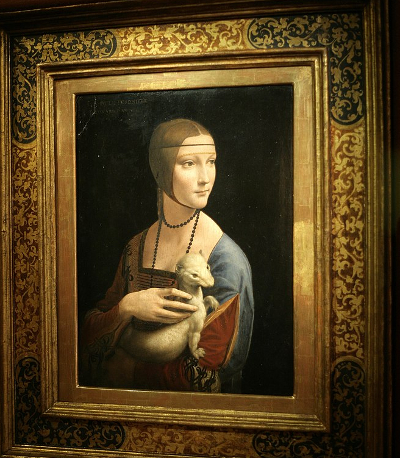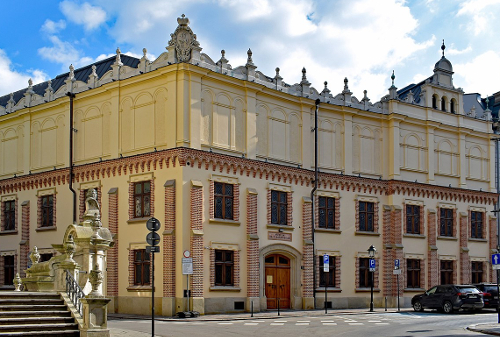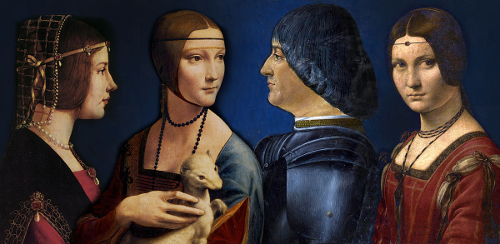Lady with an Ermine: Surprising Facts You Never Knew About
The Lady with an Ermine is one of Leonardo da Vinci’s most famous paintings. It depicts a woman holding a short-tailed weasel, also known as an ermine. The painting was created with oil on a walnut panel and is relatively small in size, measuring 54 × 39 centimeters (21 × 15 inches).

Despite the painting’s fame, there are many interesting facts about it that most people are not aware of.
For example, did you know that the Lady with an Ermine is located in Krakow, Poland? This means that there are not many opportunities to see the painting in person, making it a must-see for art enthusiasts visiting the area.
In this article, we will explore more fascinating facts about this iconic painting that you may not have known before.
Table of Contents:
History of Lady with an Ermine
Creation of the Painting
Creation of the painting Lady with an Ermine is a portrait painting that is widely attributed to the Italian Renaissance artist Leonardo da Vinci.
The painting is believed to have been created between 1489 and 1491, during da Vinci’s time in Milan.
The work is painted in oils on a panel of walnut wood. It is in small in size, measuring only 54 × 39 centimeters (21 × 15 inches).
The Model: Cecilia Gallerani
The subject of the painting is believed to be Cecilia Gallerani, a noblewoman who was the mistress of Ludovico Sforza, Duke of Milan.
Gallerani was known for her intelligence and beauty, and was a patron of the arts. She is depicted in the painting holding a short-tailed weasel, also referred to as an ermine.
The Ermine in the Painting
The ermine in the painting is believed to symbolize purity and moderation, as it was known for its white fur and the fact that it would rather die than soil its coat.
The ermine also had associations with the aristocracy, as it was often used in heraldry.
The Painting’s Patron: Ludovico Sforza
The painting was commissioned by Ludovico Sforza, who was a patron of the arts and a lover of beauty.

Sforza was known for his interest in art and literature, and he surrounded himself with artists and intellectuals. He was also a military leader and a politician, and played a key role in the politics of Renaissance Italy.
Lady with an Ermine remained in the possession of the Sforza family until the late 18th century, when it was acquired by Princess Izabela Czartoryska.
The painting is now part of the collection of the Czartoryski Museum in Kraków, Poland, which is now part of the National Museum in Kraków.

The painting has been the subject of much study and interpretation by art historians and scholars. It is considered one of da Vinci’s most important portrait paintings, and is noted for its composition, use of light and shadow, and the personality and mind of its subject.
The painting has also been compared to other da Vinci works, such as La Belle Ferronnière and the Virgin of the Rocks.

The Painting’s Composition and Style
The Ermine’s Symbolism
The Lady with an Ermine painting is a masterpiece by Leonardo da Vinci, painted in oils on a panel of walnut wood.
The painting depicts a young woman holding a white ermine, which was a symbol of purity and chastity in Renaissance art.
The ermine was also a symbol of the patron of the painting, Ludovico il Moro, who was the Duke of Milan.
The ermine was part of his coat of arms, and it is believed that the painting was commissioned to celebrate his mistress, Cecilia Gallerani, who is the lady in the painting.
The Use of Light and Shadow
Leonardo da Vinci was a master of light and shadow crossing, which is evident in the Lady with an Ermine painting.
The painting is characterized by soft lighting that creates a three-dimensional effect. The light falls on the lady’s face, highlighting her delicate features and adding depth to her expression.
The ermine’s white fur is also highlighted by the light, creating a contrast with the dark background.
The Lady’s Pose and Expression
The Lady with an Ermine painting is a portrait of Cecilia Gallerani, who was a noblewoman and the mistress of Ludovico il Moro.
The lady is depicted in a three-quarter pose, with her head slightly turned to the side. Her expression is enigmatic, and her eyes seem to follow the viewer.
The lady’s pose and expression are typical of Renaissance portrait painting, which aimed to capture the personality and mind of the sitter.
The Painting’s Background and Setting
The Lady with an Ermine painting has a dark background, which creates a contrast with the white ermine and the lady’s pale skin.
The painting’s setting is unknown, but it is believed to be a chamber in Ludovico il Moro’s palace. The painting’s composition is simple, with the lady and the ermine occupying most of the space. The painting’s simplicity and elegance are characteristic of Leonardo da Vinci’s style.
In conclusion, the Lady with an Ermine painting is a masterpiece of Renaissance painting, characterized by its symbolism, use of light and shadow, the lady’s pose and expression, and the painting’s background and setting.
The painting is an example of Leonardo da Vinci’s mastery of the oil painting technique and his ability to capture the personality and mind of the sitter.
The painting is currently housed in the Czartoryski Museum in Poland, and it is considered one of the most important works of art in the world.
Krakow: Czartoryski Museum Tour
Entrance with Krakow Card
The Czartoryski Museum in Krakow is a must-visit for art enthusiasts. The museum’s collection includes the famous painting “Lady with an Ermine” by Leonardo da Vinci. Visitors can purchase tickets at the museum entrance or use their Krakow Card for free admission.
The Krakow Card is a great option for tourists who want to save money on entrance fees and public transportation. The card provides free admission to over 36 museums and attractions in Krakow, including the Czartoryski Museum.
Visitors can also take advantage of the free audio guide included with the Krakow Card. The audio guide provides detailed information about the museum’s collection, including the history and significance of the “Lady with an Ermine” painting.
It is important to note that the Krakow Card does not include admission to temporary exhibitions or special events at the museum. Visitors should check the museum’s website for information about current exhibitions and events.
Lady with an Ermine’s Legacy
Ownership and Exhibitions
The Lady with an Ermine is a painting by the Renaissance artist Leonardo da Vinci. It is a portrait of Cecilia Gallerani, the mistress of Lodovico Sforza, Duke of Milan, and was painted around 1489.
The painting was purchased by Prince Adam Czartoryski in Italy in the late 18th century, and it has been in the collection of the Czartoryski Museum in Krakow, Poland, since then.
The painting was briefly taken by the Germans during World War II but was returned to the museum after the war.
The painting has been exhibited in various cities around the world, including Paris, Siena, and Milan. It was also displayed at the National Gallery of Art in Washington, D.C., in 1992, as part of an exhibition of Renaissance paintings from the Czartoryski collection.
Read also:
Impact on Art and Culture
The Lady with an Ermine is considered one of Leonardo’s most important paintings. The painting is notable for its use of light and shadow, its attention to detail, and its portrayal of personality and mind. The ermine in the painting is a symbol of purity and is also a reference to the coat of arms of the Sforza family.
The painting has had a significant impact on art and culture. It has been studied by art historians and scholars for centuries and has been the subject of numerous interpretations.
The painting is also notable for its use of the layer amplification method, which involves the application of thin layers of paint to create a luminous effect.
The Lady with an Ermine has influenced other artists, including Beatrice d’Este, who commissioned a portrait from Leonardo, and the Spanish painter Diego Velázquez, who was inspired by Leonardo’s use of light and shadow. The painting has also been referenced in literature, including in the works of the Italian writer Gabriele D’Annunzio.
Frequently Asked Questions
What is the significance of the ermine?
The ermine, also known as a short-tailed weasel, was a symbol of purity and chastity during the Renaissance period.
It was often associated with royalty and nobility, as it was believed that only those of high status could afford to wear ermine fur. In the painting, the ermine is held by the woman, who is believed to represent purity and virtue.
What is unique about Lady with an Ermine?
Lady with an Ermine is a unique portrait painting because it is one of the few portraits that Leonardo da Vinci painted of a woman who is not smiling.
The painting also features a woman holding an ermine, which was an unusual subject for a portrait at the time.
What is the other name of Lady with an Ermine?
The other name of Lady with an Ermine is Portrait of Cecilia Gallerani. Cecilia Gallerani was the mistress of Ludovico Sforza, who was the Duke of Milan and a patron of Leonardo da Vinci.
What is the medium used for Lady with an Ermine?
Lady with an Ermine was painted with oil on a walnut panel. The painting is in small in size, with dimensions of 54 × 39 centimeters (21 × 15 inches).
What is the difference between Lady with an Ermine and Mona Lisa?
One of the main differences between Lady with an Ermine and Mona Lisa is the subject of the paintings.
Lady with an Ermine features a woman holding an ermine, while Mona Lisa features a woman with a mysterious smile. Additionally, Lady with an Ermine is a smaller painting, and the background is less detailed than the background of Mona Lisa.
Why is Lady with an Ermine famous?
Lady with an Ermine is famous because it is a masterpiece of Renaissance art and one of the few surviving portraits painted by Leonardo da Vinci.
The painting is also unique because of the subject matter and the use of an ermine, which was a symbol of purity and chastity during the Renaissance period.










